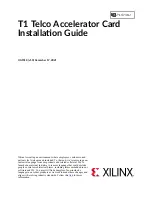
KPCI-3110 and KPCI-3116 User’s Manual
Functional Description
2-15
Data format and transfer
KPCI-3110 and KPCI-3116 boards use offset binary data encoding to represent signals. In
DriverLINX software, the analog input value is returned as a code or voltage depending on user
input. DriverLINX provides single-value and buffer methods to convert between voltages and
analog codes. The single-value functions are Volts2Code and Code2Volts. Refer to DriverLINX
manuals provided with DriverLINX for more information.
To represent unipolar signals, KPCI-3110 and KPCI-3116 boards use straight binary data encod-
ing, such as 000 (for 12-bit boards) or 0000 (for 16-bit boards) to represent 0V, and FFFh (for
12-bit boards) or FFFFh (for 16-bit boards) to represent full-scale. To represent bipolar signals,
KPCI-3110 and KPCI-3116 boards use offset binary data encoding, such as 000 (for 12-bit
boards) or 0000 (for 16-bit boards) to represent negative full-scale, and FFFh (for 12-bit boards)
or FFFFh (for 16-bit boards) to represent positive full-scale. Use software to specify the data
encoding as binary.
DriverLINX transfers data to the controlling (your program) application in buffers that the appli-
cation has allocated. The size and number of buffers that your application should allocate is a
function of Windows’ message processing and the type of stop event you have specified.
Guidance on specifying buffers
If using ‘Stop on terminal count,’ data transfer stops automatically after the specified buffer is
filled. Only a single buffer of adequate length is needed.
If using ‘Stop on trigger’ (analog or digital) or ‘Stop on command,’ the data transfer will con-
tinue indefinitely until the stop condition occurs, with buffers being used and reused to keep up
with incoming transfers. In this case, allocate enough buffers for one second’s worth of data,
plus two extras to provide a margin for recycling of used buffers. (The total number of buffers
available should equal [(Sampling Frequency / Buffer Size) + 2].)
A Windows message will be sent each time a buffer is filled. For example, at a rate of 100Hz
and a buffer of 100 samples, a buffer filled message will be sent once per second. A buffer mes-
sage rate in the range of 1 – 10 per second is recommended to avoid overloading Windows with
too many messages.
Error conditions
KPCI-3110 and KPCI-3116 boards can report the following analog input error conditions to the
host computer:
•
A/D Over Sample — Indicates that the A/D sample clock rate is too fast. This error is
reported if a new A/D sample clock pulse occurs while the ADC is busy performing a con-
version from the previous A/D sample clock pulse. The host computer can clear this error. To
avoid this error, use a slower sampling rate.
•
Input FIFO Overflow — Indicates that the analog input data is not being transferred fast
enough from the Input FIFO across the PCI bus to the host computer. This error is reported
when the Input FIFO becomes full; the board cannot get access to the PCI bus fast enough.
The host computer can clear this error, but the error will continue to be generated if the Input
FIFO is still full. To avoid this error, close other applications that may be running while you
are acquiring data. Also check if bus mastering is evaluated in B105. If this has no effect, try
using a computer with a faster processor or reduce the sampling rate.
•
Host Block Overflow — Indicates that the host computer is not handling data from the
board fast enough. This error is reported if the board completes the transfer of a block of
input data to the circular buffer in the host computer before the host computer has finished
reading the last block of data.
If any of these error conditions occurs, the board stops acquiring and transferring data to the host
computer.
NOTE
DriverLINX reports any of these errors as a “DATA LOST” message.
Summary of Contents for KPCI-3110
Page 3: ......
Page 4: ......
Page 7: ......
Page 8: ......
Page 16: ...Preface...
Page 20: ...1 Overview...
Page 25: ...2 Functional Description...
Page 54: ......
Page 55: ......
Page 57: ......
Page 58: ......
Page 59: ......
Page 61: ...3 Installation and Configuration...
Page 66: ......
Page 68: ......
Page 80: ......
Page 81: ......
Page 82: ......
Page 83: ......
Page 84: ......
Page 85: ......
Page 86: ...4 Testing the Board...
Page 89: ...5 Calibration...
Page 92: ...6 Troubleshooting...
Page 99: ...A Specifications...
Page 111: ...B Connector Pin Assignments...
Page 116: ...C Systematic Problem Isolation...
Page 143: ...D Using Your Own Screw Terminal Panel...
Page 156: ......
















































